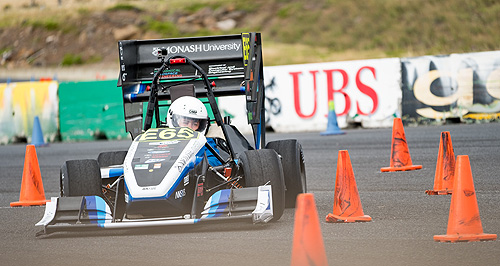News - General News - SportMonash Motorsport bounces backDouble trouble: Monash University had a combustion engine and an electric entrant in this year's Formula SAEA competition. Uni wins both categories at Formula SAEA and is set to take on Europe in 201818 Dec 2017 By IAN PORTER MONASH Motorsport bounced back onto the top rung of the Formula SAEA ladder on last week by winning both categories at the 2017 competition held at Calder Park Raceway. It was an impressive comeback for the team, which was squeezed into third place in 2016, finishing only 18 points behind the winning University of Wollongong outfit. This year Monash Motorsport (MMS) trounced the 16-car internal combustion competition with a score of 959.3 points, more than 200 points ahead of Wollongong (UOW). It was also 130 points more than MMS scored in 2016. MMS backed up its victory in the combustion car class with a strong win in the electric car (EV) category, the first time it had entered the EV class. MMS won this class with 919.3 points, comfortably clear of University of Technology, Sydney, which scored 853.7 points. Both the M17-C and M17-E cars ran reliably all weekend and dominated the final results. This reliability vindicated the team decision to design and build the cars as early as possible in order to maximise testing time. They started track work in July. The competition comprises seven different events, three static and four dynamic. The static events are the business case presentation, cost and engineering and design. The four dynamic events are skidpan, acceleration, autocross and endurance/efficiency. The MMS combustion car won a majority of the events, coming third in the cost analysis and fifth in efficiency. The MMS electric car won five events, came second in acceleration and fourth in cost analysis. “I’ve been on the team for a few years but I have never had a competition go as smoothly as it did,” said MMS business leader and suspension engineer Vincent Chu. “We knew the cars had the performance in them, it was just whether the team was able to execute during the competition.” He said the only niggles the team had involved replacing some nuts on the combustion car brake rotors during the technical inspection and needing to remove it's drag reduction system for the Endurance event due to a last minute system leak. “The electric car had one or two wiring things, and it needed some larger safety stickers, which the other teams kindly gave us. We wouldn’t have passed without them,” he said. “All the teams try to help each other out. It’s much less about being a competitive motorsport event and more about an engineering, design and learning event.” Mr Chu, who will become chief executive officer of the team next year, said MMS would be taking its cars to Europe in 2018 to compete in three rounds of the European Formula Student (FSAEA) season. MMS will be competing in the same events it ran in in 2016: UK (Silverstone), Austria (Red Bull Ring) and Germany (Hockenheimring). The rest of the team would stay home and work on a drag reduction system for the electric car and an aerodynamic undertray for the 2018 cars. There was not a hint of disappointment from the defending champions even though a couple of things went against them. “We were all pleasantly surprised about how well the combustion car ran,” UOW team leader Ben Filippi told GoAuto. “We didn’t realise how quick our package was.” Unfortunately, the electric car ran into mechanical problems and failed to score in any of the dynamic events, coming home eighth out of nine entrants. The UOW combustion team was at a horsepower disadvantage after switching to the smaller 450cc option for this year. Mr Filippi said sourcing issues prevented UOW from strapping a turbo onto the Yamaha WR450. The team had to leave a few points on the table when other cars spun out during the autocross event, causing delays and preventing the UOW driver from having a second run. The team came fifth in autocross, dropping more than 50 points to Monash. “We were unfortunate in autocross as we didn’t get our second run in. Our autocross driver was confident about going faster in the second run. That was the first time we had been on the track and with more practice we could have gone faster.” Each team has to have at least four drivers compete across the four dynamic events (skidpan, autocross, acceleration and endurance/efficiency). Drivers are allowed a maximum of two events. Mr Filippi said UOW would be back again in 2018 with a refined version of the 2017 car. “The team runs on a two-year design cycle, so we go for a new platform every two years. Next year we may come back with a turbo, or we may not. We will have to see.” Internal Combustion Class results 1. Monash University – 959.4 2. University of Wollongong – 734.8 3. Curtin University – 729.5 4. University of NSW, Sydney – 729.2 5. The University of Melbourne – 713.1 Electric Vehicle Class 1. Monash University – 919.4 2. University of Technology, Sydney – 853.7 3. The University of Queensland – 750.4 4. RMIT University – 743.4 5. The University of Auckland – 336.0  Read more11th of December 2017  Formula SAE-A competition helps boost industryIndustry minister throws weight behind the Formula SAE-A competition8th of December 2017  Formula SAE-A teams gear upMonash and RMIT prepare for this weekend’s event at Calder raceway |
Click to shareGeneral News articlesResearch General News Motor industry news |






























Facebook Twitter Instagram